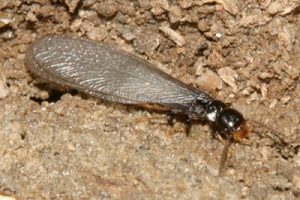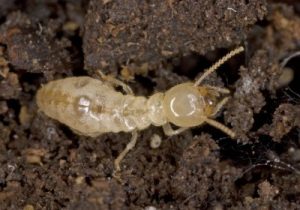
Termites can be divided into three groups: subterranean, dry-wood and damp-wood.
Subterranean termites (as it is clear from the name) live having a contact with wet ground where they build their colonies.
Every colony consists of workers, soldiers and swarmers (or alates). In order to classify termites, you have to have a look at swarmers and soldiers; you need to identify the wood damage as well.
Hide content
- Subterranean swarmers
- Swarmers’ mating season
- How winged termites look like?
- Photo
- Subterranean termites’ copulation
- If you see swarmers
- Preventive actions
- Will swarmers’ killing solve termite problem?
- Useful articles
- Helpful video
- Conclusion
As it was said before, for subterranean termites it is important to live in moisture and darkness. They can stay alive and build their nests where the weather is not cold.
If they need to move in an open space, they use special channels which are made of loamy material, or mud for protection.
Subterranean termites belong to a special type of termites that becomes a serious threat to houses. The point is that these termites prefer eating wood and other cellulose materials.They eat timber inside that’s why it may look “healthy” even if there is nothing left inside except for cover. Once wooden element is “infected”, the others get “infected” as well.
Subterranean swarmers
Do subterranean termites have wings?
Swarmers (or alates) are the only termites that have wings.
Subterranean termite swarmers can be also called mothers. Basically they exist for reproductive functions.
Can subterranean termites fly? Not all of them can fly but they always have two pairs of wings which are almost close to being the same in length.
Reproductives can be primary and secondary. Primary reproductives are those which perform king and queen functions in the nest.
Secondary swarmers are not mature enough for copulation process but they live to replace primaries if something happens.
Swarmers’ mating season
When do subterranean termites swarm? Depending on climate termites’ mating season may differ. In the areas with temperate climate season starts in summer; in desert – in winter, after rains.In tropics some subterranean termites prefer choosing dry periods when there are no rains. Most probably that might be explained by their future nest location as rain makes wood and ground soft but fills in the space in the ground.
Some termites’ types have quite unpredictable mating season, it can be even several times a year. But it is known that heterotermes, for example, start their copulation ten minutes after the sunset and it lasts for one hour.
How winged termites look like?
Usual subterranean termites’ swarmers have from brown to black color, two pairs of wings (as it was said earlier), and are about 0,25-0,5 inch long.
There are two types of swarmers: winged reproductive males (kings) and females (queens). Comparing with other classes of termites, swarmers are bigger in size.
Sometimes swarmers can be confused with flying ants. But comparing with ants, they are smaller and have straight (not bent) antennae. Flying ants also have four wings, but their first two wings are located in front and they are bigger than pair behind.
Learn more about subterranean termites: signs of their activity; best methods of treatment and DIY methods. Eastern subterranean termites and their tunnels and tubes with photo.Photo
See pictures below with subterranean termites swarmers:
Subterranean termites’ copulation
Subterranean termites’ mating period is ending with making a couple: they have their copulation after, in the nest. Their flying distance may be different: from one to hundreds of meters.
Generally, male swarmer connects with his female partner after that they land on the ground, shed their wings and start looking for a place for their nest.Future queen and king need to dig a hole (it can be also called a channel). The major work is done by queen; male swarmer protects her from the others which couldn’t make a couple.
After finishing the channel they close it using soil; and start copulation inside. After a couple of days the female swarmer lays eggs, the number of eggs can be enormous.
While being “pregnant” queen’s body gets 10 times bigger, what makes her unable to move. If it is needed to move her, large quantities of workers unite.
New winged termites will appear only after 2-3 years, when the nest becomes highly populated.
Swarmers stay underground or within wood all the time the nest exists. One colony can survive for ten years producing thousands of termites.
Some female swarmers do not fly though they have wings. They climb up the grass and try to attract male swarmer with their appearance and wings noise.
Caution! If you see small pieces that look like fish scales, most probably these are wings. You have to check whether they are of the same size or not: as they might have been left by termites.
If you see swarmers
As it was mentioned, subterranean swarmers can be mistaken for flying ants.
Have a look at them (or at their wings if they had been shed) carefully.
If these are ants, standard insecticide usage will be enough.
If you see flying termites near your house, most probably you have or will have their nest close to your living place. So, it is time to think and check wooden constructions.
You can do it by yourself but it would be better to call termite control.
Advice! Do not wait for termites appearance, do some preventive actions.Depending on the weather and climate conditions there are some places where swarmers fly into the house because of lights switched on. Usually, if swarmers cannot find a place for nest or leave your house, they die.
So, you will find large quantities of them or their wings on the floor or ceiling. Sometimes the number of reproductives can be tremendous. As an option it may be recommended to switch off the lights in the house room by room.
In this case termites will follow the light. You should switch off the lights the way you are moving out of the house. Slowly they will move to a new source of light outside the house. Don’t forget about special actions that will prevent termites’ future appearance.
Advice! If you feel comfortable with reptiles, you can take gecko: they will be your saviors against termites.Here you can learn more information about effective treatment method called tenting (fumigation): dangers for termites, preparing for fumigation and cleaning after, how long does this procedure last?
Preventive actions
Getting rid of termites and their swarmers can be hard, so if it is possible, try to do some preventive actions against their appearance:
- If you are building a house, try to do it with high foundation. Wooden constructions shouldn’t be in contact with the ground.
- Dig a trench around the house and fill it in with the sand. Termites like moving in the ground (not in the sand). To make your trench more effective you can add some insecticides against termites.
- Try to get rid of wet ground and moisture around your house.
- If you have a wooden fence, make sure it doesn’t have any contact with the ground. It will be also a good idea to make a cement or stone base for it.
- Make sure your drains work properly and carry off rainwater.
- Make ventilation system for your house.
- You should know that subterranean termites do not like cedar, mahogany and some other types of wood.
- There are special remedies to keep your timber dry.
- Keep firewood away from the house.
- If you see splitting in walls of your house, fill them in with sealant.
Will swarmers’ killing solve termite problem?
Actually no. The problem is that if you kill subterranean swarming termites, you will prevent upcoming nest appearance but you will not protect yourself from their future coming.
Useful articles
If you interested in more information of termites we recommend you to read the following articles:
- All types of termites. Are they harmful to humans? Can they bite you? And what is the difference between drywood and subterranean ones?
- What does swarmers of different species look like: drywood, formosan?
- Signs of infestation outside and in the house: in walls or furniture.
- What does termite holes look like? What is droppings and is it toxic to humans? Do termites make noises?
- Posible termite damage, how does it look like? Examples of damage in walls and wood floors.
- All about flying termites: how do they look like, swarming season and what to do if there are swarmers in your house?
- How do they do nests and mounds? How to find it in your garden or inside the house?
- Termite life cycle – from egg to larvae. And social hierarchy: workers, soldiers, queen.
Helpful video
Watch short video below about termite swarmers:
https://www.youtube.com/watch?v=leDEJPmatl0
Conclusion
Remember, that swarmers do not damage your wood by themselves – that’s subterranean workers’ job. If you see swarmers inside or near your house that should signalize you that your territory could have been chosen by termites. So, it is time call professional pest control service.







